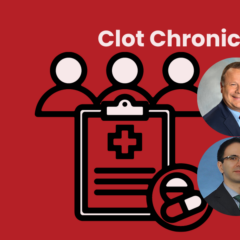Last updated on
Clot Chronicles: Atrial Fibrillation Awareness Month
September is Atrial Fibrillation Awareness Month! In this episode of the Clot Chronicles, Dr. Sam Goldhaber discusses impact of atrial fibrillation and the important treatments available to patients.
Hello, I am Dr. Sam Goldhaber, president of NATF, and today’s Clot Chronicles is on the topic of atrial fibrillation. September is Atrial Fibrillation Month, so this is a very appropriate time for us to discuss the widespread condition of atrial fibrillation, which affects millions of Americans each year. Atrial Fibrillation is associated with an increase in age. And, as we have the graying of America, we project that over the next decade or so millions of additional Americans will have atrial fibrillation.
Until recently, atrial fibrillation was considered to be a heart rhythm disease and we used to focus either on controlling the rate of atrial fibrillation to keep the heart rate somewhere in the range of 60 to 100 beats per minute rather than having a more rapid heart rate, or we would concentrate on trying to restore a normal sinus rhythm with a regular beat to beat situation in order to improve the heart function.
When patients have atrial fibrillation, they lose the atrial contribution to their cardiac output. So, this means that atrial fibrillation, which supplies about 20% of the cardiac output, is unable to give the normal amount of forward blood flow. In that situation often atrial fibrillation is accompanied by fatigue from lower cardiac output or decreased exercise tolerance. On the other hand, some patients have no idea that they are in atrial fibrillation, even if their heart rate becomes very rapid.
However, our concept of atrial fibrillation has changed. Now, we view atrial fibrillation as a systemic vascular illness, which is just expressing itself as atrial fibrillation. But, those with AF often have cigarette smoking or high blood pressure, or high cholesterol, or a sedentary lifestyle, which are major risk factors. In fact, now there are some atrial fibrillation clinics that put a lot of focus on managing cardiovascular risk factors by encouraging more exercise, encouraging more heart-healthy eating, encouraging adequate control of the blood pressure, so that it goes no higher than 130/80 mm of mercury, by lowering the cholesterol often with statin drugs, and by making sure patients with atrial fibrillation quit cigarette smoking.
With these measures, these primary care general cardiology measures, the frequency of atrial fibrillation under certain circumstances will decrease and under other circumstances the frequency of rapid heart rates with atrial fibrillation might decrease. On top of this, of course, we will many times prescribe an anticoagulant to prevent stroke and other times we will invert the rhythm from atrial fibrillation to a regular sinus rhythm either with electrocardioversion, and, if that fails, with antiarrhythmic medications, and, if that fails, with radio-frequency ablation in the electrophysiology laboratory.
Atrial fibrillation is garnering additional attention because it is a multi-disciplinary problem with a multi-disciplinary approach to managing it being the best approach. I think that September is a great month for us to check and make sure we don’t have atrial fibrillation, and in general, even if we have a normal heart rhythm, to make sure that we are living a heart-healthy lifestyle.
This is Dr. Sam Goldhaber, signing off for the Clot Chronicles.



